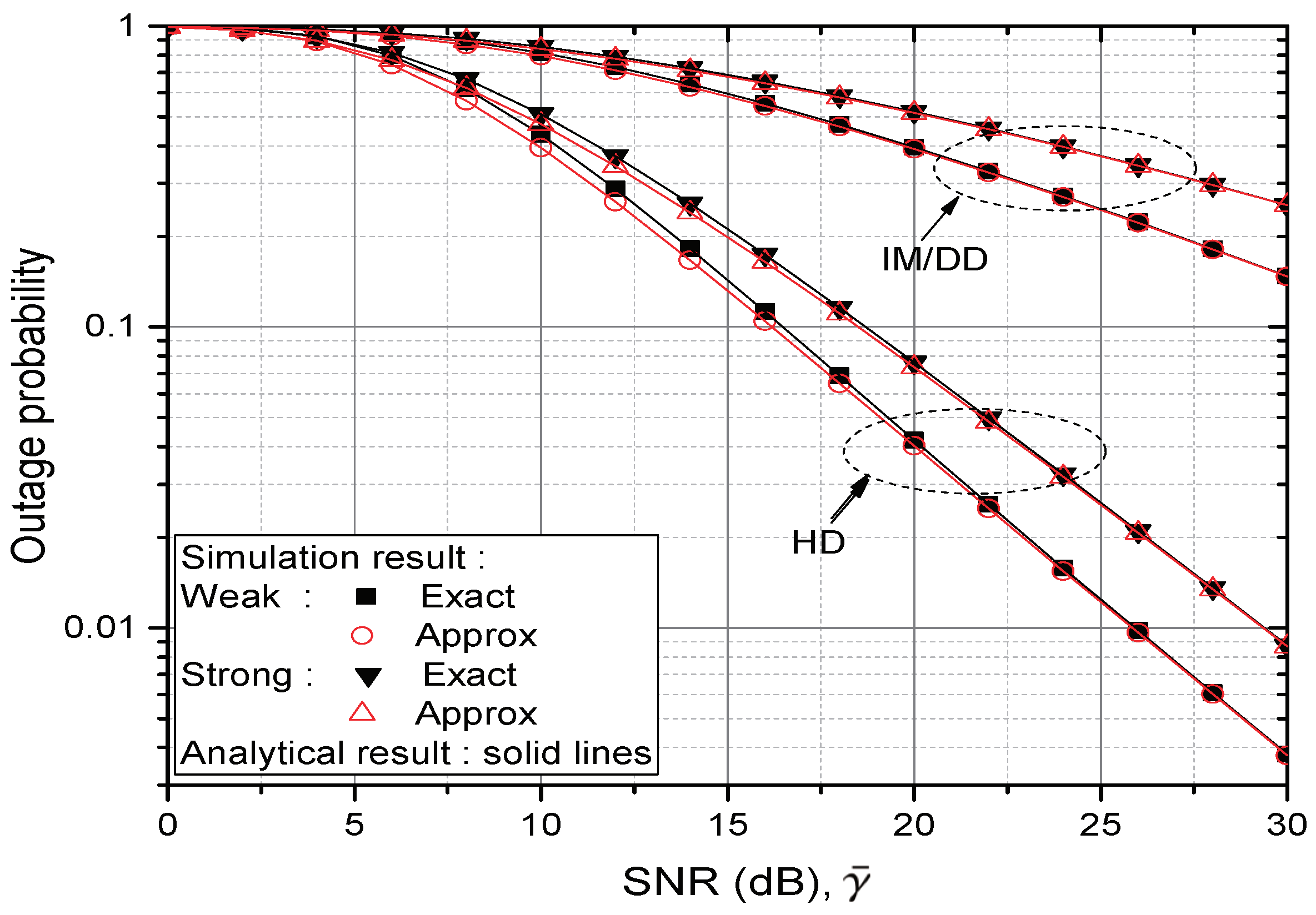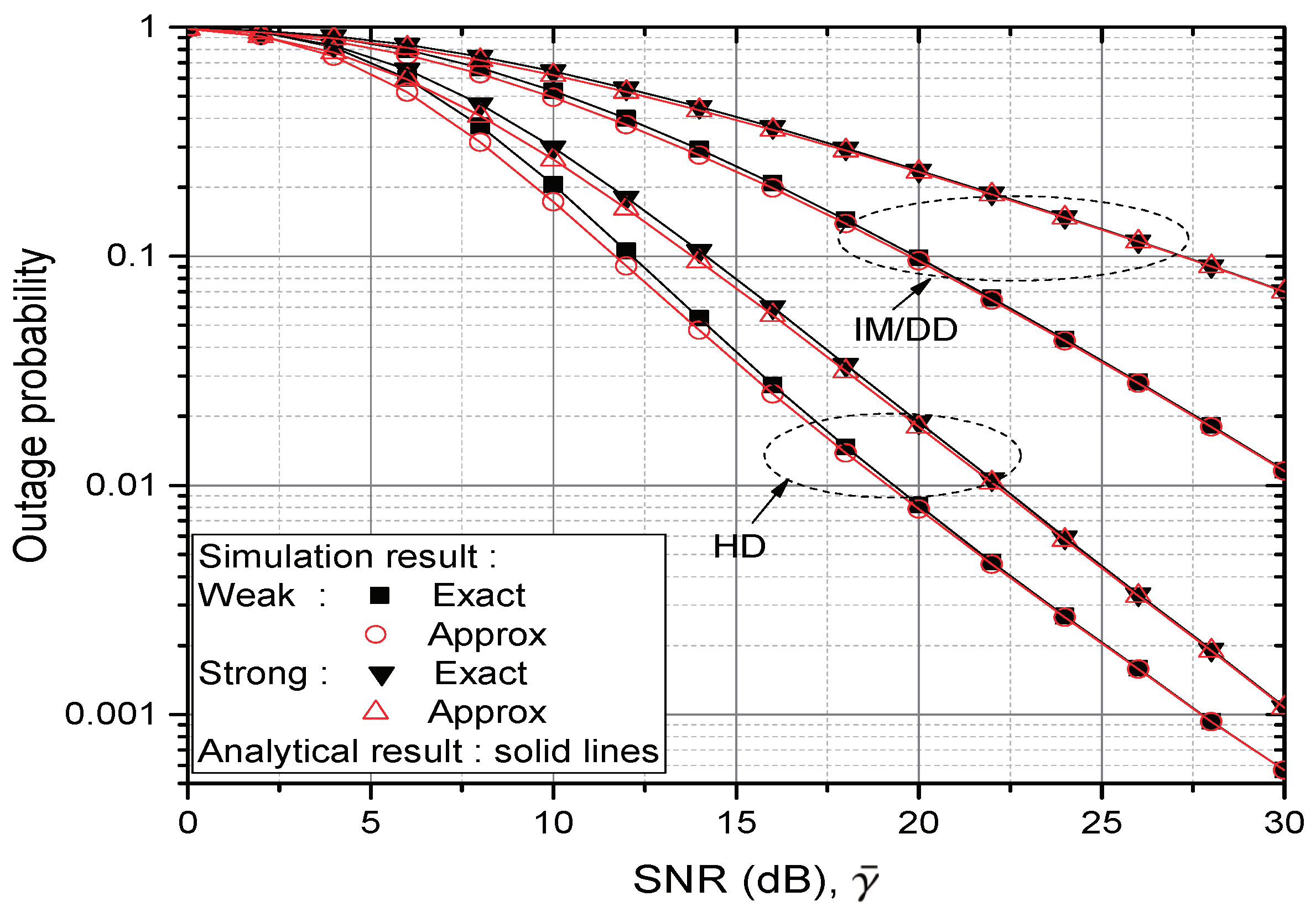Statistical Analysis of Noise Propagation Effect for Mixed RF/FSO AF Relaying Application in Wireless Sensor Networks
Abstract
:1. Introduction
2. System Model and Fading Statistics
3. Exact Statistical Analysis of
4. Application of for Performance Evaluation
4.1. Outage Probability
4.2. Average BER
4.3. Ergodic Capacity
5. Numerical Results
6. Conclusions
Author Contributions
Funding
Conflicts of Interest
Abbreviations
| AF | Amplifying-and-forwarding |
| BER | Bit-error rate |
| CDF | Cumulative distribution function |
| DF | Decoding-and-forward |
| DGG | Double generalized Gamma |
| EGK | Extended generalized-K |
| FSO | Free-space optical |
| HD | Heterodyne detection |
| IM/DD | Intensity-modulation/direct-detection |
| MGF | Moment generating function |
| OP | Outage probability |
| Probability density function | |
| RF | Radio frequency |
| SNR | Signal-to-noise power ratio |
References
- Kim, I.; Kim, D. Minimizing operational power cost in remote-area wireless sensor networks with a DF relay and outage constraints. IEEE Commun. Lett. 2015, 19, 247–250. [Google Scholar] [CrossRef]
- Kim, I.; Kim, D. Minimizing source-sum-power consumption in multi-sensor single-relay networks. IEEE Trans. Commun. 2011, 59, 2362–2366. [Google Scholar] [CrossRef]
- Arnon, S.; Barry, J.; Karagiannidis, G.; Schober, R.; Uysal, M. Advanced Optical Wireless Communication Systems; Cambridge University Press: Cambridge, UK, 2012. [Google Scholar]
- Chan, V.W.S. Free-space optical communications. J. Lightw. Technol. 2006, 24, 4750–4762. [Google Scholar] [CrossRef]
- Zedini, E.; Ansari, I.S.; Alouini, M.-S. Performance analysis of mixed nakagami- m and gamma-gamma dual-hop FSO transmission systems. IEEE Photon. J. 2015, 7, 1–20. [Google Scholar] [CrossRef] [Green Version]
- Arnon, S. Effects of atmospheric turbulence and building sway on optical wireless-communication systems. Opt. Lett. 2003, 28, 129. [Google Scholar] [CrossRef] [PubMed]
- Ashrafzadeh, B.; Soleimani-Nasab, E.; Kamandar, M.; Uysal, M. A framework on the performance analysis of dual-hop mixed FSO-RF cooperative systems. IEEE Trans. Commun. 2019, 67, 4939–4954. [Google Scholar] [CrossRef]
- Hasna, M.; Alouini, M.-S. End-to-end performance of transmission systems with relays over rayleigh-fading channels. IEEE Trans. Wireless Commun. 2003, 2, 1126–1131. [Google Scholar] [CrossRef] [Green Version]
- Kim, J.-B.; Kim, D. Comparison of tightly power-constrained performances for opportunistic amplify-and- forward relaying with partial or full channel information. IEEE Commun. Lett. 2009, 13, 100–102. [Google Scholar]
- Zedini, E.; Soury, H.; Alouini, M.-S. On the performance analysis of dual-hop mixed FSO/RF systems. IEEE Trans. Wireless Commun. 2016, 15, 3679–3689. [Google Scholar] [CrossRef] [Green Version]
- Aggarwal, M.; Garg, P.; Puri, P. Exact MGF-based performance analysis of dual-hop AF-relayed optical wireless communication systems. J. Lightw. Technol. 2015, 33, 1913–1919. [Google Scholar] [CrossRef]
- Lee, I.-H.; Kim, D. Outage probability of multi-hop MIMO relaying with transmit antenna selection and ideal relay gain over rayleigh fading channels. IEEE Trans. Commun. 2009, 57, 357–360. [Google Scholar] [CrossRef]
- Mathonline. Available online: http://mathonline.wikidot.com/newton-s-generalization-of-the-binomial-theorem (accessed on 30 May 2019).
- Rudin, W. Real and Complex Analysis; McGraw Hill Education India: New Delhi, India, 2015. [Google Scholar]
- Moision, B.; Erkmen, B.; Keyes, E.; Belt, T.; Bowen, O.; Brinkley, D.; Csonka, P.; Eglington, M.; Kazmierski, A.; Kim, N.-H.; et al. Demonstration of free-space optical communication for long-range data links between balloons on Project Loon. In Proceedings of Free-Space Laser Communication and Atmospheric Propagation XXIX; SPIE: San Francisco, CA, USA, 2017. [Google Scholar]
- Gappmair, W. Further results on the capacity of free-space optical channels in turbulent atmosphere. IET Commun. 2011, 5, 1262–1267. [Google Scholar] [CrossRef]
- Farid, A.A.; Hranilovic, S. Outage capacity optimization for free-space optical links with pointing errors. J. Lightw. Technol. 2007, 25, 1702–1710. [Google Scholar] [CrossRef] [Green Version]
- Gradshteyn, I.S.; Ryzhik, I.M. Table of Integrals, Series and Products; Academic: New York, NY, USA, 2000. [Google Scholar]
- Sagias, N.; Zogas, D.; Karagiannidis, G. Selection diversity receivers over nonidentical weibull fading channels. IEEE Trans. Veh. Technol. 2005, 54, 2146–2151. [Google Scholar] [CrossRef] [Green Version]
- Tang, X.; Ghassemlooy, Z.; Rajbhandari, S.; Popoola, W.; Lee, C. Coherent polarization shift keying modulated free space optical links over a gamma-gamma turbulence channel. Amer. J. Eng. Appl. Sci. 2011, 4, 520–530. [Google Scholar]



| HD | IM/DD | ||||||||
|---|---|---|---|---|---|---|---|---|---|
| = 1 | = 6.7 | = 1 | = 6.7 | ||||||
| Turbulence | SNR | BER | BER | BER | BER | ||||
| Weak | 10 | 9.28 | 5.69 | 12.17 | 3.97 | 3.35 | 8.08 | 6.88 | 5.64 |
| 20 | 3.72 | 0.46 | 3.72 | 0.27 | 1.30 | 0.90 | 2.79 | 0.55 | |
| 30 | 0.52 | 0.03 | 0.38 | 0.02 | 0.25 | 0.08 | 0.54 | 0.04 | |
| Moderate | 10 | 8.79 | 5.74 | 11.61 | 4.06 | 2.83 | 7.97 | 5.57 | 5.70 |
| 20 | 3.59 | 0.47 | 4.12 | 0.29 | 1.09 | 0.92 | 2.08 | 0.58 | |
| 30 | 0.42 | 0.03 | 0.50 | 0.02 | 0.21 | 0.08 | 0.45 | 0.05 | |
| Strong | 10 | 7.76 | 5.83 | 10.26 | 4.25 | 2.44 | 7.82 | 4.64 | 5.71 |
| 20 | 3.09 | 0.50 | 4.13 | 0.32 | 0.92 | 0.92 | 1.64 | 0.61 | |
| 30 | 0.47 | 0.04 | 0.74 | 0.02 | 0.18 | 0.09 | 0.29 | 0.05 | |
© 2020 by the authors. Licensee MDPI, Basel, Switzerland. This article is an open access article distributed under the terms and conditions of the Creative Commons Attribution (CC BY) license (http://creativecommons.org/licenses/by/4.0/).
Share and Cite
Jeong, D.-K.; Park, C.-S.; Kim, D. Statistical Analysis of Noise Propagation Effect for Mixed RF/FSO AF Relaying Application in Wireless Sensor Networks. Sensors 2020, 20, 979. https://doi.org/10.3390/s20040979
Jeong D-K, Park C-S, Kim D. Statistical Analysis of Noise Propagation Effect for Mixed RF/FSO AF Relaying Application in Wireless Sensor Networks. Sensors. 2020; 20(4):979. https://doi.org/10.3390/s20040979
Chicago/Turabian StyleJeong, Dae-Kyo, Cheol-Sun Park, and Dongwoo Kim. 2020. "Statistical Analysis of Noise Propagation Effect for Mixed RF/FSO AF Relaying Application in Wireless Sensor Networks" Sensors 20, no. 4: 979. https://doi.org/10.3390/s20040979





